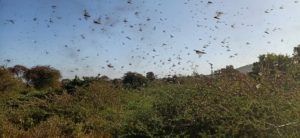 Stories
Stories
January 15, 2021 • 3 min read
Communities still recovering from last year’s infestation and the impact of Covid-19
GOAL Ethiopia is responding to a new desert locust infestation which is threatening agricultural livelihoods and food security for thousands across the country. The latest threat comes a year after locust swarms affected millions of people across East Africa.
Last year’s outbreak was the worst recorded in Kenya for 70 years. Hundreds of millions of insects also swarmed into neighbouring nations, such as Somalia and Ethiopia. A new locust outbreak could now compound an already bleak food security situation in Ethiopia. 8.6 million people currently face high levels of food insecurity, due to Covid-19, displacement and high food prices.
Collective action needed to fight new outbreak
Early last year, swarms of desert locusts started to spread across countries in the Horn of Africa, devastating crops and people’s livelihoods. To avoid a humanitarian crisis, the UN called for collective action. Up to $194 million was raised to fight the outbreak last year. One year on, the agency has said that $80 million could now be needed to control the scourge in the coming months.
The UN has warned that immature swarms in the Horn of Africa have been migrating southwards from breeding areas in eastern Ethiopia and central Somalia to southern Ethiopia and northern Kenya. In Ethiopia, the swarms are concentrating along the eastern side of the Harar Highlands in Oromia region as they move to southern areas of the country.
Many regions are already suffering with other food insecurity threats
12 local administrative areas in the Teltelle district of the Oromia Region of Ethiopia are now seriously affected. Dinkneh Asfaw, GOAL Ethiopia’s Country Director, says that communities in the Teltelle district are struggling to cope with the new infestation.
‘‘This community has not had time to recover from last year’s outbreak. They are even more vulnerable to this new risk. The infestation is now impacting 3,211 households and a total area of 3,275 hectares of crop land and almost 8,000 hectares of grazing lands. The food security situation could be even more serious, as erratic rain in the area is expected to decrease much of the crop yield that was cultivated during 2020,’’ he added.
The new locust outbreak has also impacted the districts of Dillo and Dhas, with thousands of hectares being affected in both regions. Last year, thanks for the generous support to our donors from the Eruopean Union and Irish Aid, GOAL supported local authorities with infestation control measures, helping over 9000 families protect their farms from the insects and through distribution of cash assistance of multiple rounds in Teltele and Elwaye districts in Borena zone. GOAL teams are currently identifying the needs of local communities before offering financial assistance and seed support.

Locust swarm in Ethiopia
Early control measures critical
Desert Locusts are considered the most destructive migratory pest in the world, devouring large areas of crops and grasses meant for people and livestock. According to the UN’s Food and Agriculture Organization (FAO), a swarm of 40-80 million locusts can consume the amount of food equivalent to that eaten by 35,000 people in a day.
Strengthening early detection and control measures are critical in the fight against locust infestations. And a vital tool for farmers in the wider battle against food insecurity. GOAL teams are on the ground helping local farmers to cope with the locust threat and ensure communities have access to food supplies. You can support this work with a donation today.
